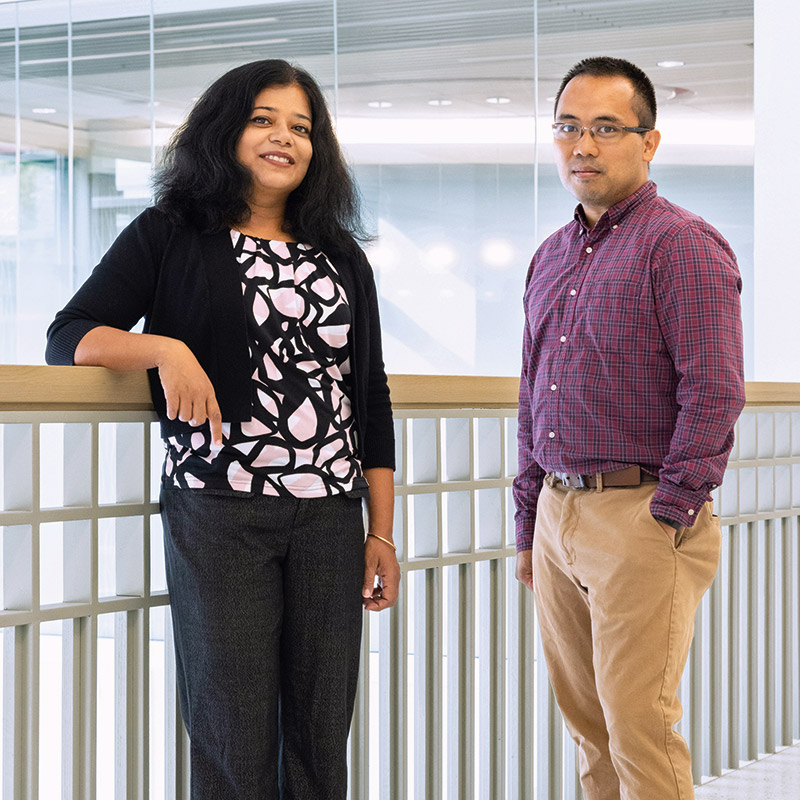Analyzing big data to understand the developing brain

The Masonic Institute for the Developing Brain (MIDB) will soon open its doors to patients, ushering in a new era of research to diagnose, prevent, and treat neurological disorders from early childhood through adolescence. The institute brings together a number of research disciplines from across the University of Minnesota. Co-leading the core data analytics area are School of Public Health (SPH) biostatistics faculty members Assistant Professor Mark Fiecas (also a member of the data science graduate faculty) and Professor Saonli Basu.
To begin with, what exactly will you do at the new institute?
Fiecas: My day-to-day will involve providing guidance to researchers in analyzing the data they collect, developing software for analysis, and providing consultation on studies, which sometimes may require developing new statistical methods.
The data is getting bigger and bigger, and there’s a continual need for more sophisticated techniques to analyze it.
Basu: Like Mark said, it’s our knowledge of how to use statistical and computational tools to handle big data that got us involved in MIDB. We will be assisting with study design, data analysis, writing papers, and helping with the grant submissions. There’s so much about the developing brain that we don’t know and the MIDB analytics core will help accelerate progress in filling in the gaps.
What do you specialize in as SPH faculty?
Fiecas: A lot of the work I do involves developing statistical methods for analyzing brain images, and much of my research is related to adolescent mental health, specifically depression. Can we use data about the brain as it develops to predict the onset of depression, and what does a brain look like for children who have suicidal thoughts and behaviors?
Basu:I specialize in statistical genetics and genomics. This means I use statistical models to draw inferences from genetic data, for example, identifying genes and environmental factors that contribute to the development of different diseases. One thing I’ve studied, for example, is genetic and environmental influence on substance use and psychiatric disorders.
What issues or areas of research dedicated to infants, children, and adolescents are you particularly driven to address?
Fiecas: Certainly adolescent mental health is extremely important to me, especially since I recently became a parent. I’ve been working on adolescent mental health studies for a couple of years now and it’s become a very personal thing for me. I’m creating a model for how different parts of the brain talk to each other using data from MRI brain images. We take hundreds of pictures of the brain within minutes, and by studying these brain images, we’re working toward predicting the severity of depression.
Basu: I’m involved with the Minnesota Center for Twin and Family Research studies, focusing on the role of genetics in drug abuse, alcohol, and tobacco addiction problems in adolescents. You need advanced techniques to meaningfully look for patterns and I have developed software to find which genes seem responsible for influencing addiction problems. If we can predict risk, that could really help with developing proper and timely intervention strategies. There’s so much about the developing brain that we don’t know and the MIDB analytics core will help accelerate progress in filling in the gaps.
Why is brain development a public health issue?
Fiecas: Well, mental health is certainly a public health issue, and it’s linked to brain development. Take the pandemic and the mental health effects of social isolation on U of M students, for example. Can we intervene before the onset of depression or suicidal thoughts and behaviors? Because if this is something that we can get ahead of, then we can intervene much earlier in order to dampen the effects.
Basu: Trying to understand what underlies addiction or mental health problems that kids develop is a public health issue. And those problems are increasing at an alarming rate. If we can identify risk factors and come up with appropriate interventions, that would be amazing.